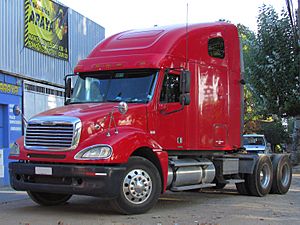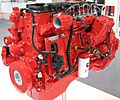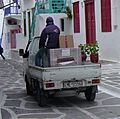Cabin (truck) facts for kids
The cabin or cab is the special area in a truck where the driver sits. It's like the cockpit of an airplane, but for a truck! Modern truck cabs, especially those for long trips, are designed to be very comfortable. They often have air conditioning, a great sound system, and super comfy seats. These seats are often "air-suspended," meaning they use air to make the ride smoother. Even Pickup truck cabs can be as comfortable as a car inside!
Contents
Types of Truck Cabs
Trucks come in many shapes and sizes, and so do their cabs! The type of cab often depends on what the truck is used for.
Pickup Truck Cabs
Pickup trucks are popular for everyday use and lighter jobs. Their cabs usually come in three main types:
- Regular cab: This is the simplest type. It has 2 doors and just one row of seats. It can usually fit one or two passengers along with the driver.
- Extended cab: This cab has a bit more space behind the front seats. It might have two, three, or four doors. The extra space is usually for a small back seat or for storing things.
- Crew Cab: This is the biggest pickup truck cab. It always has 4 doors, just like a regular car. It's sometimes called a "double cab" because it has two full rows of seating, making it great for carrying more passengers.
Cabs for Larger Trucks
Bigger trucks, like those that carry heavy loads or travel long distances, have different cab designs. These designs help drivers stay comfortable and safe on the road.
Sleeper Cabs
A sleeper is a special area attached to the back of the truck cab. It's like a small bedroom where the driver can rest and sleep. You'll often see sleepers on semi-trailer trucks that travel across the country.
Sleeper compartments can be small, just a simple bunk bed about 2 to 4 feet long. But some can be huge, like a 12-foot "apartment-on-wheels"! These larger sleepers can have beds, tables, and even small kitchens. They allow drivers to spend weeks on the road, moving important cargo from one place to another.
Cab Over Engine (COE)
A Cab Over Engine (COE) truck is also known as a flat nose truck. In these trucks, the driver sits right on top of the front axle and the engine. This design became popular before World War II.
COE trucks have a shorter wheelbase (the distance between the front and back wheels). This makes them easier to turn and park in tight spaces. They also offer the driver a great view of the road. To get to the engine for repairs, the entire cab of a COE truck tilts forward! These trucks are still very common for medium and light-duty jobs in the United States.
Conventional Cabs
Conventional cabs are the most common type of truck cab in places like North America and Australia. In these trucks, the driver sits behind the engine, much like in a pickup truck or a car.
Conventional cabs are often divided into two types:
- "Large car" or "long nose" trucks have a very long hood, often 6 to 8 feet or more. Because of their square shape, these trucks push a lot of air as they drive. This creates more wind resistance, which means they use more fuel. They also don't offer as good visibility as COE or aerodynamic trucks.
- Aerodynamic cabs are designed to be very streamlined. They have a sloped hood and other features that help them cut through the air easily. This reduces drag and helps save fuel. The front doors of these cabs are usually behind and above the front tires. To get into a conventional cab, drivers usually use steps located near the fuel tank(s) behind the front tires.
Images for kids
-
Freightliner M2 dump truck
-
A ROMAN dump truck in Brașov, Romania, 2013
-
DAF tractor with an auto-transport semi-trailer carrying Škoda Octavia cars in Cardiff, Wales




























